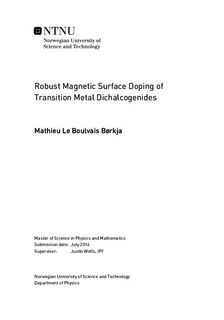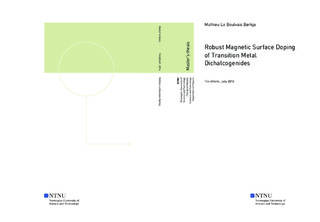| dc.contributor.advisor | Wells, Justin | |
| dc.contributor.author | Børkja, Mathieu Le Boulvais | |
| dc.date.accessioned | 2016-10-28T14:00:29Z | |
| dc.date.available | 2016-10-28T14:00:29Z | |
| dc.date.created | 2016-07-04 | |
| dc.date.issued | 2016 | |
| dc.identifier | ntnudaim:14794 | |
| dc.identifier.uri | http://hdl.handle.net/11250/2418193 | |
| dc.description.abstract | The growth and potential intercalation of Fe on naturally grown MoS$_{2}$ has been studied using a number of surface techniques.
An initial sample characterization revealed that samples extracted from the natural MoS$_{2}$ crystal contained few impurities and were well suited to the purposes of this experiment.
Fe thermally evaporated onto the MoS$_{2}$ surface was found to be only weakly interacting with it, easily desorbing during heating.
For the quantities of Fe used in this experiment the growth appeared to be uniform.
When deposited at room temperature, and when annealed at temperatures up to 100$^{\circ}$C, the Fe did not show any signs of having intercalated into the MoS$_{2}$.
On Fe dosed samples annealed at higher temperatures (400$^{\circ}$C+) ARXPS measurements revealed hints that the Fe may have intercalated.
However, due to the amount of Fe that was thermally desorbed in the annealing process, this cannot be concluded with certainty.
The Fe was observed to surface dope the sample.
It was additionally found that this shift could be reversed by deposition of an alkali metal.
A series of preliminary electronic band structure measurements were made on the new hybrid materials.
These measurements revealed no clear evidence of band structure alterations due to magnetic effects. | |
| dc.language | eng | |
| dc.publisher | NTNU | |
| dc.subject | Fysikk og matematikk, Teknisk fysikk | |
| dc.title | Robust Magnetic Surface Doping of Transition Metal Dichalcogenides | |
| dc.type | Master thesis | |
| dc.source.pagenumber | 122 | |

